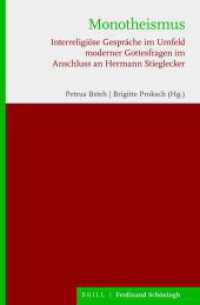- ホーム
- > 洋書
- > 英文書
- > Science / Mathematics
基本説明
This volume addresses some of the most prominent and fascinating facets of questions as they pertain to the growth and development of both yeast and hyphal forms of fungi, beginning with subcellular components – then cell organization, polarity, growth, differentiation and beyond – to the cell biology of spores, biomechanics of invasive growth, plant pathogenesis, mycorrhizal symbiosis and colonial networks. Throughout, structural, molecular and ecological aspects are integrated to form a contemporary look at the biology of the fungal cell.
Full Description
Mycology, the study of fungi, originated as a subdiscipline of botany and was a descr- tive discipline, largely neglected as an experimental science until the early years of this century. A seminal paper by Blakeslee in 1904 provided evidence for sel?ncompatib- ity, termed "heterothallism", and stimulated interest in studies related to the control of sexual reproduction in fungi by mating-type speci?cities. Soon to follow was the demonstration that sexually reproducing fungi exhibit Mendelian inheritance and that it was possible to conduct formal genetic analysis with fungi. The names Burgeff, Kniep and Lindegren are all associated with this early period of fungal genetics research. These studies and the discovery of penicillin by Fleming, who shared a Nobel Prize in 1945, provided further impetus for experimental research with fungi. Thus began a period of interest in mutation induction and analysis of mutants for biochemical traits. Such fundamental research, conducted largely with Neurospora crassa,led to theone gene: one enzyme hypothesis and to a second Nobel Prize for fungal research awarded to Beadle and Tatum in 1958.Fundamental research in biochemical genetics was extended to other fungi, especially to Saccharomyces cerevisiae, and by the mid-1960s fungal systems were much favored for studies in eukaryotic molecular biology and were soon able to compete with bacterial systems in the molecular arena.
Contents
1 The Endomembrane System of the Fungal CellTimothy M. Bourett, Steven W. James and Richard J. Howard 2 Motile Tubular Vacuole SystemsAnne E. Ashford and William G. Allaway 3 The Fungal Woronin BodyTejaswini Dhavale and Gregory Jedd 4 A Molecular and Genomic View of the Fungal Cell WallFrans M. Klis, Arthur F.J. Ram and Piet W.J. De Groot 5 The Cytoskeleton and Polarized Growth of Filamentous FungiReinhard Fischer 6 Polarised Growth in FungiPeter Sudbery and Helen Court 7 Signal Transduction and Morphogenesis in Candida albicansAlistair J.P. Brown, Silvia Argimon and Neil A.R. Gow 8 Mating in Candida albicans and Related SpeciesDavid R. Soll 9 Ions Regulate Spore Attachment, Germination, and Fungal GrowthBrian D Shaw and Harvey C. Hoch 10 Biomechanics of Invasive Hyphal GrowthNicholas P. Money 11 Cell Biology of Fungal and Oomycete Infection of PlantsAdrienne R. Hardham 12 Fair Trade in the Underworld: the Ectomycorrhizal SymbiosisFrancis Martin 13 Network Organisation of Mycelial FungiMark Fricker, Lynne Boddy and Daniel Bebber








